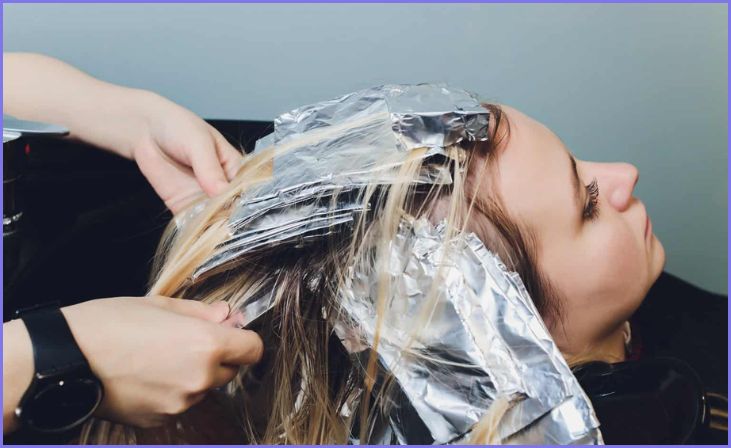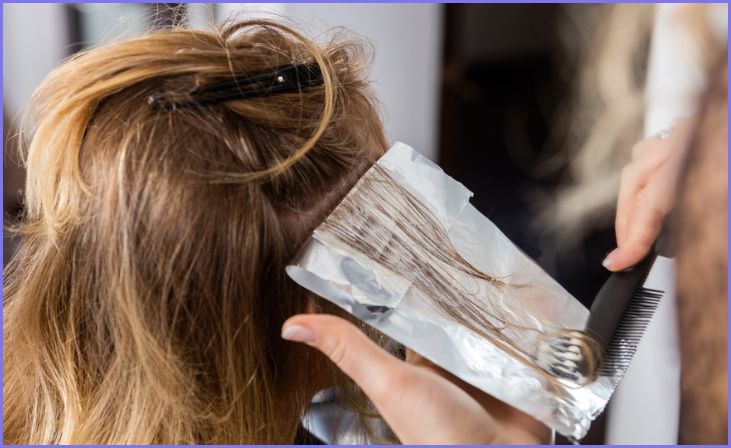Foil highlights are a transformative hair coloring technique, allowing for precision and customization that can elevate your overall look. Whether you’re aiming for sun-kissed strands or bold streaks, the key to achieving stunning results lies in the duration that foils remain in your hair. In this comprehensive guide, we’ll delve into the intricacies of foil highlighting, exploring the factors that influence processing time and uncovering tips for achieving the perfect hue.
What are Foil Highlights?
Foil highlights involve sectioning hair into thin strands and applying color or lightener to create dimension. The process is meticulously executed by wrapping each treated strand in a foil sheet, creating a barrier that enhances color development. This method is preferred for its precision, allowing hairdressers to target specific areas for customized results.
Factors Influencing Processing Time

Hair Type and Condition
Understanding your hair type and its current condition is pivotal in determining how it will respond to various hair care practices, including color treatments like foil highlights. Hair types range from straight to wavy, curly, and coily, each with its unique characteristics. Additionally, considering the condition of your hair—whether it’s fine, medium, or coarse, and its overall health—affects how quickly color processes and how resilient it is to chemical treatments. Coarser hair may require more processing time, while finer hair might lighten more swiftly.
The health of your hair is equally crucial; well-moisturized, healthy hair tends to respond more favorably to color treatments, showcasing vibrant results. Therefore, before embarking on any color journey, a thoughtful analysis of your hair type and condition guides professionals in tailoring treatments for optimal and personalized outcomes.
Desired Result
The desired result in hair coloring, particularly with foil highlights, is a subjective vision that varies from person to person. It encompasses the specific look you aim to achieve, whether it’s subtle dimension, striking contrast, or a complete transformation. Foil highlights offer a versatile range of possibilities—from sun-kissed strands to bold streaks—and the processing time is intricately tied to realizing this vision. If your goal is a more natural appearance, a shorter processing time may be suitable.
Conversely, if you aspire to achieve a dramatic shift in color, a longer processing time is often required to reach the desired level of lift. Clearly communicating your vision to your stylist ensures they can tailor the technique and processing time to achieve the exact result you’re envisioning, bringing your hair color dreams to life.
Also Read- Best 9 Tips to Keep Your Curls Healthy and Beautiful
Developer Strength
The developer strength in hair coloring, including foil highlights, plays a crucial role in the overall processing time and the ultimate outcome of the color transformation. Developers, typically available in volumes ranging from 10 to 40, contain peroxide, which facilitates the lightening or coloring process. The choice of developer strength depends on factors such as the desired result, the starting color of the hair, and the hair’s condition. Higher volume developers, such as 30 or 40, have a more potent lifting effect, allowing for quicker color processing.
However, it’s essential to balance this speed with the potential for increased damage to the hair. A skilled stylist carefully selects the developer strength based on their expertise and an assessment of the client’s hair, ensuring a harmonious blend of effective color processing and maintaining optimal hair health.
Foil Technique
The foil technique is a fundamental aspect of hair coloring, particularly in the application of highlights. This method involves sectioning the hair into thin strands and applying color or lightener to create dimension and depth. Each treated strand is then carefully wrapped in a foil sheet, creating a barrier that enhances color development and prevents bleeding into adjacent sections. The foil technique provides precision and control, allowing stylists to target specific areas for a customized and tailored look.
Different foil techniques, such as slicing, weaving, and teasing, offer varied results. Slicing creates uniform and defined highlights, weaving produces a more blended effect, and teasing imparts a softer transition between colored and natural strands. The choice of foil technique is often influenced by the desired outcome and the stylist’s expertise, ensuring a personalized and visually appealing result.
Color or Lightener Used
The choice of color or lightener in hair coloring, particularly when employing foil highlights, significantly influences the overall outcome of the process. Colors are used for tinting the hair, adding depth and richness, while lighteners are employed to lift the natural color of the hair, creating highlights or achieving an overall lighter shade. The type of color or lightener selected impacts the processing time, the level of lift, and the final hue.
Professional-grade products often offer a more predictable and controlled result, allowing stylists to customize the color transformation based on the client’s preferences and hair characteristics. The expertise of the stylist in choosing the appropriate color or lightener ensures that the desired effect is achieved while considering the health and integrity of the hair.
Determining Processing Time

Perform Strand Tests
Performing strand tests is a crucial step in the hair coloring process, especially when considering foil highlights. This method involves applying a small amount of the color or lightener mixture to a discreet section of hair to assess how it reacts before proceeding with the full treatment. Strand tests serve several purposes, such as gauging the processing time needed to achieve the desired result and identifying potential adverse reactions.
By conducting these tests, stylists can fine-tune the formulation and make adjustments based on the hair’s response, ensuring that the final outcome aligns with the client’s expectations and maintaining the health of the hair. It’s a proactive approach that enhances the precision and effectiveness of the foil highlighting process while minimizing the risk of unexpected outcomes.
Monitor Color Development
Monitoring color development is a critical aspect of the foil highlighting process. Stylists regularly check the foils to assess how the color or lightener is processing and to ensure that the desired level of lift is achieved. This vigilant observation helps prevent over-processing, which can lead to damage and undesirable results. The duration that foils remain in the hair is contingent on the color transformation goals and the individual characteristics of the hair being treated.
By carefully monitoring color development, stylists can make informed decisions about when to remove the foils, ensuring that the final result is both visually appealing and in harmony with the client’s expectations. This attention to detail is key to achieving optimal and personalized foil highlights.
Tips for Optimal Results

Consultation with Your Stylist
A consultation with your stylist is a foundational step in the hair coloring journey, particularly when considering foil highlights. This collaborative discussion provides an opportunity for you to articulate your desires and for the stylist to offer their expertise. By clearly communicating your vision, including the desired outcome, preferred color tones, and overall look, you empower your stylist to tailor the foil highlighting technique to your unique features and style preferences.
During the consultation, the stylist assesses factors such as your hair type, its current condition, and your base color. This comprehensive understanding allows them to recommend an appropriate processing time, developer strength, and foil technique, ensuring that the final result aligns seamlessly with your expectations. A well-informed consultation sets the stage for a successful and personalized foil highlighting experience.
Consider Your Base Color
Considering your base color is a crucial element in the planning and execution of foil highlights. Your base color, or your current hair color, serves as the starting point for the color transformation. Darker base colors may require additional processing time to achieve lighter results, while lighter bases may lift more quickly. The stylist takes into account your base color during the consultation, assessing its depth and undertones.
This evaluation influences decisions about the color or lightener formulation, the developer strength, and the overall foil highlighting technique. By considering your base color, the stylist can create a harmonious and balanced transition, ensuring that the foil highlights seamlessly blend with your existing hair color for a natural and visually stunning result.
Protect Hair Health
Protecting the health of your hair is a paramount consideration when undergoing any color treatment, including foil highlights. The chemical processes involved in coloring can impact the hair’s structure, potentially leading to dryness, breakage, or damage. To safeguard your hair health during and after foil highlights, it’s essential to implement protective measures. Regular deep conditioning treatments nourish and moisturize the hair, minimizing the impact of chemicals and maintaining its overall vitality.
Additionally, adopting a proper at-home hair care routine, which includes using sulfate-free and color-safe shampoos and conditioners, helps preserve the vibrancy of the color while promoting optimal hair health. By prioritizing hair health, you contribute to the longevity of your foil highlights and ensure that your hair remains resilient and lustrous.
Click Here- How often should you get your Hair Trimmed?
Be Realistic About Processing Time
Being realistic about processing time is a key aspect of achieving successful and satisfying foil highlights. While the desire for a swift transformation is natural, it’s crucial to understand that the processing time is intricately linked to the final result. Rushing the process may lead to uneven color development, over-processing, and potential damage to the hair. During the consultation with your stylist, realistic expectations should be established based on factors such as your hair type, its current condition, and the desired outcome.
Trusting the expertise of your stylist and acknowledging that achieving the perfect color takes time contributes to a positive and effective foil highlighting experience. Embracing patience ensures that each strand is carefully treated, resulting in a more even, vibrant, and harmonious color transformation.
Why Use Aluminum Foil When Dying Hair?

Using aluminum foil when dyeing hair serves several practical purposes in the color application process. The primary benefits include:
Precision Application
Precision application in hair coloring is a technique that involves meticulous and targeted placement of color to achieve specific results. By using precise application methods, such as brushes or foils, stylists can control where the color is deposited, allowing for intricate detailing. This is particularly important in highlighting or lowlighting processes, where isolating specific strands or sections creates a more customized and natural look. Precision application ensures that each strand is treated with care, resulting in a harmonious and well-blended final color that complements the individual’s unique features and style preferences. This technique allows for a tailored approach to hair coloring, enhancing the overall precision and artistry of the final result.
Enhanced Processing
Enhanced processing in hair coloring refers to the intensified development of color achieved through specific techniques or tools. Using methods like foiling or heat application, color processing is heightened, leading to more vibrant and saturated results. Enhanced processing, often facilitated by aluminum foil, allows the color or lightener to work more effectively, resulting in a more pronounced and long-lasting hue. This technique is particularly beneficial when seeking bold or intricate color transformations, as it ensures that the hair fully absorbs and expresses the desired shade with enhanced depth and richness.
Prevention of Color Bleeding
The prevention of color bleeding is a critical aspect of using aluminum foil in hair coloring. When applying different colors or shades to specific sections of the hair, the foil acts as a protective barrier. This barrier prevents the colors from bleeding into each other, ensuring that each strand retains its distinct hue without unwanted blending. The foil isolates the treated sections, maintaining the precision of the color application. By preventing color bleeding, stylists can achieve clean and well-defined results, whether creating highlights, lowlights, or intricate color patterns. This contributes to a polished and professional appearance, enhancing the overall success of the hair coloring process.
Heat Retention
Heat retention is a beneficial feature of using aluminum foil in hair coloring. The foil serves as a conductor, trapping heat around the treated sections during the coloring process. This gentle heat aids in accelerating the color development by opening the hair cuticle, allowing the dye or lightener to penetrate more effectively. Heat retention is particularly advantageous when using products that benefit from warmth for optimal results. By creating a warmer environment around the colored strands, aluminum foil enhances the overall processing time, contributing to more vibrant and thorough color saturation. This technique is widely used to achieve efficient and consistent results in various hair coloring applications.
Versatility
Versatility is a key attribute of using aluminum foil in hair coloring. The material provides a flexible and adaptable tool for various highlighting techniques, making it a go-to choice for stylists. Whether creating traditional highlights, balayage, ombre, or other customized effects, aluminum foil allows for precise and controlled color placement. Stylists can easily mold the foil to fit the desired pattern, ensuring tailored and creative results. The versatility of foil extends beyond technique; it accommodates different hair lengths, textures, and styles. This adaptability makes aluminum foil an indispensable element in the hairstylist’s toolkit, enabling them to unleash their creativity and achieve diverse and personalized color transformations for their clients.
Conclusion
Foil highlights are a dynamic and versatile coloring technique, offering a spectrum of possibilities for enhancing your hair’s natural beauty. The question of how long foils should stay in your hair is nuanced, influenced by factors ranging from your hair type to the desired result. Collaborating with a skilled stylist ensures that the process is tailored to your unique features and preferences. So, whether you’re aiming for a subtle sun-kissed glow or bold, statement-making highlights, the artistry of foil highlights unfolds through careful consideration of these factors and a commitment to achieving stunning, personalized results.
FAQs
The processing time for foil highlights varies based on factors such as hair type, desired result, and the products used. It can range from 20 minutes to an hour or more.
Yes, there is a limit to how long foils should stay in the hair. Leaving them on for too long can lead to over-processing, causing damage to the hair. A professional stylist monitors the foils to ensure optimal results.
Achieving drastic color changes may require multiple sessions, especially if you’re going significantly lighter. It’s essential to discuss realistic expectations and the process with your stylist during a consultation.







